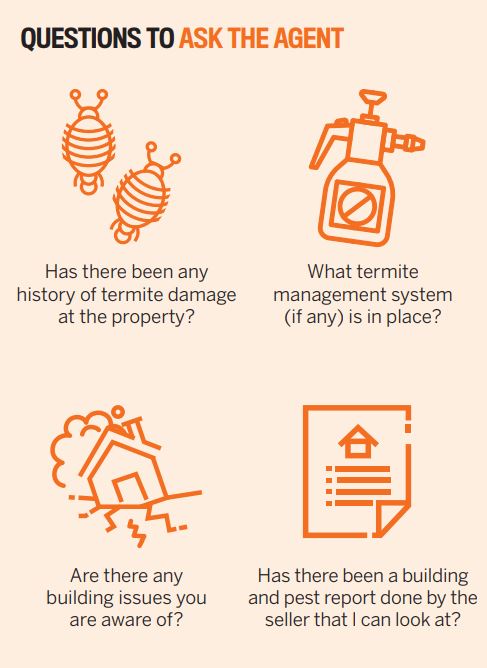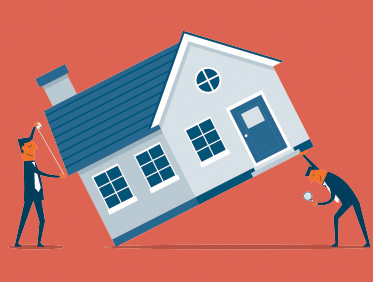
A property investor can learn to spot more obvious significant defects so they can screen out undesirable properties before incurring the cost of a building and pest inspection, which can be anything from $440 to $990 for a standard-sized house.
Ideally, buildings should be well designed and built to standards so that they are compliant and durable. Then a property needs maintenance to keep it in good condition. Any deficiency in these areas can result in additional costs and risks, like health and safety hazards. So how do you know if the building is well designed, well built and well maintained? You need to check it yourself or have a professional check it for you.
Exterior checklist
Have a close look at the property yourself before hiring a professional, as you may spot some issues and decide to find a property in better condition before spending the money on a professional inspection.

Have a look at sheds and other outbuildings. Small structures that are less than 10sqm typically don’t need official council approval. Check concreted, paved and tiled areas like the driveway, paths and patios for cracks and subsidence that could be a tripping hazard.
Check the decks, balconies, patios and stairs. These are low-maintenance when made of durable materials like concrete and aluminium typically found in apartment buildings. Timber structures are relatively high-maintenance, and annual painting and repairs should be budgeted for. Check that handrails are sturdy and at a safe height, and look for any signs of rotting or loose timber. Rusted bolts and fixings are very common around pool areas due to the effect of nearby chlorinated water.
Check the floors. If the house has a timber floor and you can get under it easily enough, have a look below if it is safe to access. Use your phone torch to get some light, and check the condition of the posts. Cracked or rusting posts are expensive to replace. A musty smell or damp soil can be a sign of inadequate surface drainage and ventilation that can attract mould, decay and termites.
Check external walls. A few hairline cracks are normally not a problem, but larger cracks can indicate structural damage, particularly if floors are not level and windows and doors are jamming. Peeling paint and rotting boards in a timber home can be a significant expense. Refer cracks to an expert for assessment as these could be a deal breaker.
Check the windows. Aluminium windows are low-maintenance. They might need a service after 20 years. Timber windows in older buildings are higher-maintenance and could need significant repairs. It is common for the glass in older buildings to not be safety glass, and this can be a safety hazard – check with a glazier to be sure. Do the windows and doors have flyscreens and security screens fitted? These can be expensive to fi t and are becoming standard in many properties.
Have a look at the roof if you can see it from the ground. Older houses may have rusted roofs and gutters, or downpipes not connected to the stormwater drainage system. Tiled roofs can often have cracked bedding and pointing that needs repairs. Look for sagging of the roof line that could indicate a structural problem.
Is there a pool or spa? These allow for a great lifestyle but cost thousands every year in electricity and maintenance. Cracks in the pool shell should ring alarm bells, and old filtration equipment will soon need to be replaced. Pool fencing needs to strictly comply with safety standards. Ask the seller for evidence of pool safety barrier compliance.
Don’t forget to check the car accommodation, too. And then you’re ready to start inside.
Interior checklist
It starts with the easy things, like opening and closing some windows and doors. Look to see whether the frames are square, level and plumb. Floors should be level, too. In every room, you should check ceilings and walls for water stains, cracks or sagging. A few hairline cracks may be acceptable, but a lot of cracking could be a structural issue.
Window leaks can be costly to fi x, so look for stains around windows. Are there window coverings installed and are the cords safe? Dangling cords can be a strangulation risk for young children.
Remember to also ensure that stairs have safe handrails and enough head clearance. Then begin your more in-depth, room-by-room inspections.
Bathrooms, kitchens and laundries
- Wet areas like bathrooms, kitchens and laundries need close attention to plumbing fixtures for signs of water damage and dampness that could indicate a leak.
- Shower leaks in particular can be costly to rectify as often the shower needs to be replaced when the waterproof membrane has failed. This could cost upwards of $5,000.
- Also check for cracked and loose tiles and damaged fittings. Get the OK from the agent and test the included kitchen appliances if you are onsite.
- Don’t forget to run the taps to see if the hot water works and to test the water pressure.
 Older homes
Older homes
- Older homes have character but also have more defects. If the home is more than 30 years old, the risk of lead paint, asbestos, rusted plumbing and flood-affected or unauthorised building work is higher, and these issues could cost you money to rectify. None of these matters are covered by a standard building inspection, so you need to be aware of what is your responsibility to check.
- It’s a good idea to pay for a separate plumbing and electrical inspection when buying an older property. This ensures that essential items like an electrical safety switch and smoke detectors are installed and working properly.
- Ask your inspector what additional investigations they recommend.
Renovations and new builds
- New and freshly renovated properties look great, but looks can be deceiving. Check that all the work was done by licensed tradespeople, and necessary approvals were obtained and inspections done.
- Ask the sales agent or your solicitor for the necessary evidence – like a Form 21 certificate issued by a Building Certifier.
- Brand-new houses also need a careful inspection by the buyer. Known as a pre-handover, practical completion or pre-settlement inspection, this is important to ensure the quality of finish meets standards, and that inclusions match the specifications.
- Use quality painter’s masking tape and tear off a square and place it next to defects you can reach.

After your DIY inspection is complete, you may decide to engage the services of a professional as well. When choosing an inspector, make sure they are licensed and insured as required in your state. It’s also a good idea to check Google reviews. It’s tough to claim on an inspector’s indemnity insurance as they have so many disclaimers and exclusions, so it’s best to get an inspector with a lot of experience and a great reputation. Don’t select an inspector based on price; the $100 you save today may cost you tens of thousands later on.
Inspectors check a property to standards AS4349.1 and AS4349.3 for major building defects, safety hazards and timber pests. They will inspect all reasonably accessible areas.
However, inspectors don’t have to include comment on compliance, unauthorised building work, electricals, concealed plumbing, appliances, cable internet, asbestos, lead paint or concealed defects.
For example, if the interior of a property has peeling paint, there are two car bodies in the backyard, the garage door opening device is broken, the air-conditioning system doesn’t work, the house is under a flight path, there is no cable connection, and there is a gas leak, none of this will be covered by the standard building inspection.

This could add up to costing many thousands of dollars to rectify, or may not be fixable at all. This is why you need to use your own checklist and look at the property yourself. If you can be present at the building inspection, ask the agent if it’s OK for you to check that the appliances work, especially essentials such as the air-conditioning and cooktop. If you can’t be there, ask your buyer’s agent or property manager to check these things for you.
Final note on units and apartments
When buying a unit, apartment or townhouse in a complex, take the time to have a good look over the rest of the property.
Is it well maintained or shabby? Look especially at the condition of driveways, paths, retaining walls and gardens. Are retaining walls cracked and leaning over? Is there adequate visitor parking? Does the exterior need a repaint?
Poorly maintained strata properties can be a bad investment because they do not attract quality tenants, and the lack of maintenance reduces the rental returns and resale value – and increases the risk of an insurance claim.
Most attached housing such as units, townhouses and apartments are part of a body corporate and subject to its rules. Ask your solicitor or conveyancer to carry out a detailed search of body corporate records on a property you are considering investing in. Low levels in the maintenance fund of a body corporate, ongoing legal disputes or building defects are all red flags that require further investigation to ensure you will not be caught out by a major increase in levies to cover these expenses. The results of this search can influence whether you purchase the property, so request the searches early on.
 Andrew Mackie-Smith
Andrew Mackie-Smith
is a Your Investment Property
award-winning building and pest inspector and
keen property investor from BuildingPro
Disclaimer: The advice in this article is a guide only. No person should rely solely on the contents of this article without also obtaining advice from a qualified building and pest inspector and/or solicitor.

